Key Concepts Used in Climate Change Mitigation Strategies in the Coffee Sector
Abstract
1. Introduction
2. Materials and Methods
2.1. Data Collection
- (TITLE-ABS-KEY (“carbon footprint”) OR TITLE-ABS-KEY (“carbon neutral”) OR TITLE-ABS-KEY (“carbon neutrality”) OR TITLE-ABS-KEY (“low carbon”) OR TITLE-ABS-KEY (“net-zero emission”) AND TITLE-ABS-KEY (coffee)) AND (LIMIT-TO (DOCTYPE, “ar”) OR LIMIT-TO (DOCTYPE, “ch”) OR LIMIT-TO (DOCTYPE, “re”)).
2.2. Data Cleaning and Curation
2.3. Bibliometric Analysis
3. Results
3.1. Trajectory of Publications Related to Concepts for Climate Change Mitigation in Coffee
3.2. Annual Trend vs. The Impact of Publications
3.3. Country Productivity
3.4. Outstanding Journals with Publications Related to Climate Change Mitigation Concepts in Coffee
3.5. Prolific Authors and Collaboration Among Them
3.6. Historical Evolution
3.6.1. Central Article
3.6.2. Cited Articles
3.6.3. Secondarily Connected Articles
3.6.4. Temporal Evolution
3.6.5. Different Thematic Groups or Periods
3.7. Analysis of Knowledge Areas
3.8. Research Interests and Themes
3.8.1. Dimension 1 (Dim 1)
3.8.2. Dimension 2 (Dim 2)
3.8.3. Upper-Right Quadrant (Motor Themes)
3.8.4. Upper-Left Quadrant (Niche Themes)
3.8.5. Lower-Right Quadrant (Basic Themes)
3.8.6. Lower-Left Quadrant (Emerging or Declining Themes)
3.8.7. Additional Observations
3.9. Outstanding Documents
3.10. Most Utilized Strategy in Coffee to Mitigate Climate Change
4. Conclusions
Supplementary Materials
Author Contributions
Funding
Institutional Review Board Statement
Informed Consent Statement
Data Availability Statement
Acknowledgments
Conflicts of Interest
Abbreviations
| GHG | Greenhouse gases |
| CO2 | Carbon dioxide |
| CH4 | Methane |
| N2O | Nitrous oxide |
| PFC | Perfluorocarbons |
| HFC | Hydrofluorocarbons |
| SF6 | Sulfur hexafluoride |
References
- Abdullah, A.A. Global effects of atmospheric emissions. NeuroQuantology 2021, 19, 35–42. [Google Scholar] [CrossRef]
- Al-Ghussain, L. Global warming: Review on driving forces and mitigation. Environ. Prog. Sustain. Energy 2019, 38, 13–21. [Google Scholar] [CrossRef]
- Dilmore, R.; Zhang, L. Greenhouse gases and their role in climate change. In Green Energy and Technology; Springer: Berlin/Heidelberg, Germany, 2018; pp. 15–32. [Google Scholar]
- Wójcik-Gront, E. Analysis of sources and trends in agricultural GHG emissions from annex I countries. Atmosphere 2020, 11, 392. [Google Scholar] [CrossRef]
- Abodunrin, T.J.; Emetere, M.E. Multidecadal trends in Ikogosi Temperature and Rainfall to Climate change. In IOP Conference Series: Earth and Environmental Science, Proceedings of the International Conference on Energy and Sustainable Environment, Ota, Nigeria, 23–25 June 2020; IOP Publishing Ltd.: Bristol, UK, 2021. [Google Scholar]
- Fankhauser, S.; Smith, S.M.; Allen, M.; Axelsson, K.; Hale, T.; Hepburn, C.; Kendall, J.M.; Khosla, R.; Lezaun, J.; Mitchell-Larson, E.; et al. The meaning of net zero and how to get it right. Nat. Clim. Change 2022, 12, 15–21. [Google Scholar] [CrossRef]
- Balgehshiri, S.K.M.; Zohuri, B. The impact of energy transition to net-zero emissions on the world economy and global strategies. J. Econ. Manag. Res 2023, 4, 2–7. [Google Scholar] [CrossRef]
- Loyarte, E.; Barral, M.; Morla, J.C. Methodology for carbon footprint calculation towards sustainable innovation in intangible assets. Sustainability 2020, 12, 1629. [Google Scholar] [CrossRef]
- Zou, C.; Xiong, B.; Xue, H.; Zheng, D.; Ge, Z.; Wang, Y.; Jiang, L.; Pan, S.; Wu, S. The role of new energy in carbon neutral. Pet. Explor. Dev. 2021, 48, 480–491. [Google Scholar] [CrossRef]
- Zheng, Y.; Yu, H.; Zhang, Y. A bibliometric review on carbon accounting in social science during 1997–2020. Environ. Sci. Pollut. Res. 2022, 29, 9393–9407. [Google Scholar] [CrossRef]
- Yu, Y.; Zhang, N. Low-carbon city pilot and carbon emission efficiency: Quasi-experimental evidence from China. Energy Econ. 2021, 96, 105125. [Google Scholar] [CrossRef]
- Navarro Bringas, E.; Godawatte, G.A.G.R. Shedding light on the efforts into the rehabilitation of a major culprit of carbon emissions: A scientometric analysis of net-zero in the built environment sector. Energy Build. 2022, 266, 112119. [Google Scholar] [CrossRef]
- Giraldi-Díaz, M.R.; De Medina-Salas, L.; Castillo-González, E.; León-Lira, R. Environmental impact associated with the supply chain and production of grounding and roasting coffee through life cycle analysis. Sustainability 2018, 10, 4598. [Google Scholar] [CrossRef]
- Yue, T.; Liu, H.; Long, R.; Chen, H.; Gan, X.; Liu, J. Research trends and hotspots related to global carbon footprint based on bibliometric analysis: 2007–2018. Environ. Sci. Pollut. Res. 2020, 27, 17671–17691. [Google Scholar] [CrossRef]
- Yang, Y.; Meng, G. The evolution and research framework of carbon footprint: Based on the perspective of knowledge mapping. Ecol. Indic. 2020, 112, 106125. [Google Scholar] [CrossRef]
- Li, X.; Hu, S.; Jiang, L.; Han, B.; Li, J.; Wei, X. Bibliometric Analysis of the Research (2000–2020) on Land-Use Carbon Emissions Based on CiteSpace. Land 2023, 12, 165. [Google Scholar] [CrossRef]
- Cui, W.; Wei, Y.; Ji, N. Global trends of waste-to-energy (WtE) technologies in carbon neutral perspective: Bibliometric analysis. Ecotoxicol. Environ. Saf. 2024, 270, 115913. [Google Scholar] [CrossRef] [PubMed]
- Zhang, Z.; Xu, C.; Cheng, G.; Lau, E.V. Towards carbon neutrality: A comprehensive study on the utilization and resource recovery of coal-based solid wastes. Int. J. Coal Sci. Technol. 2025, 12, 34. [Google Scholar] [CrossRef]
- He, J.; Li, Z.; Zhang, X.; Wang, H.; Dong, W.; Du, E.; Chang, S.; Ou, X.; Guo, S.; Tian, Z. Towards carbon neutrality: A study on China’s long-term low-carbon transition pathways and strategies. Environ. Sci. Ecotechnol. 2022, 9, 100134. [Google Scholar] [CrossRef]
- Wang, J.; Zhou, Y.; Cooke, F.L. Low-carbon economy and policy implications: A systematic review and bibliometric analysis. Environ. Sci. Pollut. Res. 2022, 29, 65432–65451. [Google Scholar] [CrossRef]
- Hanafi, I.; Zahir, Z.; El Bahaoui, J.; Mata Cabrera, F.M.; Haboubi, K. The evolution of net zero emissions research: A bibliometric investigation. Sci. Afr. 2024, 24, e02228. [Google Scholar] [CrossRef]
- Huang, L.; Chen, K.; Zhou, M. Climate change and carbon sink: A bibliometric analysis. Environ. Sci. Pollut. Res. 2020, 27, 8740–8758. [Google Scholar] [CrossRef]
- Wu, F.; Geng, Y.; Tian, X.; Zhong, S.; Wu, W.; Yu, S.; Xiao, S. Responding climate change: A bibliometric review on urban environmental governance. J. Clean. Prod. 2018, 204, 344–354. [Google Scholar] [CrossRef]
- Filho, W.L.; Setti, A.F.F.; Azeiteiro, U.M.; Lokupitiya, E.; Donkor, F.K.; Etim, N.N.; Matandirotya, N.; Olooto, F.M.; Sharifi, A.; Nagy, G.J.; et al. An overview of the interactions between food production and climate change. Sci. Total Environ. 2022, 838, 156438. [Google Scholar] [CrossRef]
- Liu, C.; Li, K. Mapping the field: A bibliometric analysis of land use and carbon emissions (LUCE) research from 1987 to 2018. Libr. Hi Tech 2020, 39, 396–411. [Google Scholar] [CrossRef]
- Wei, J.; Liang, G.; Alex, J.; Zhang, T.; Ma, C. Research progress of energy utilization of agricultural waste in China: Bibliometric analysis by citespace. Sustainability 2020, 12, 812. [Google Scholar] [CrossRef]
- Donthu, N.; Kumar, S.; Mukherjee, D.; Pandey, N.; Lim, W.M. How to conduct a bibliometric analysis: An overview and guidelines. J. Bus. Res. 2021, 133, 285–296. [Google Scholar] [CrossRef]
- Grant, M.J.; Booth, A. A typology of reviews: An analysis of 14 review types and associated methodologies. Health Inf. Libr. J. 2009, 26, 91–108. [Google Scholar] [CrossRef]
- Mengist, W.; Soromessa, T.; Legese, G. Method for conducting systematic literature review and meta-analysis for environmental science research. MethodsX 2020, 7, 100777. [Google Scholar] [CrossRef] [PubMed]
- Martín-Martín, A.; Thelwall, M.; Orduna-Malea, E.; Delgado López-Cózar, E. Google Scholar, Microsoft Academic, Scopus, Dimensions, Web of Science, and OpenCitations’ COCI: A multidisciplinary comparison of coverage via citations. Scientometrics 2021, 126, 871–906. [Google Scholar] [CrossRef] [PubMed]
- Tan, X.C.; Zhu, K.W.; Sun, Y.L.; Zhao, W.Y.; Chen, F. Bibliometric research on the development of climate change in the BRI regions. Adv. Clim. Change Res. 2021, 12, 254–262. [Google Scholar] [CrossRef]
- van Eck, N.J.; Waltman, L. Software survey: VOSviewer, a computer program for bibliometric mapping. Scientometrics 2010, 84, 523–538. [Google Scholar] [CrossRef] [PubMed]
- Aria, M.; Cuccurullo, C. bibliometrix: An R-tool for comprehensive science mapping analysis. J. Inf. 2017, 11, 959–975. [Google Scholar] [CrossRef]
- Bradford, S.C. Sources of information on specific subjects. Engineering 1934, 137, 85–86. [Google Scholar]
- Lotka, A.J. The frequency distribution of scientific productivity. J. Wash. Acad. Sci. 1926, 16, 317–323. [Google Scholar]
- Lenzen, M.; Moran, D.; Kanemoto, K.; Foran, B.; Lobefaro, L.; Geschke, A. International trade drives biodiversity threats in developing nations. Nature 2012, 486, 109–112. [Google Scholar] [CrossRef]
- Karim, A.R.M.; Susanto, R.; Azhari, I.; Utami, S.P.; Heltina, D. Biomass Extraction as Green Corrosion Inhibitor for Low Carbon Steel in Hydrochloric Acid Solution. In Journal of Physics: Conference Series, Proceedings of the Universitas Riau International Conference on Science and Environment 2020 (URICSE-2020), 11–13 September 2020, Pekanbaru, Indonesia; Saktioto, N., Nugroho, T.T., Taib, S., Evelyn, N., Linda, R., Wahibah, N.N., Hermita, N., Novitri, N., Dahnilsyah, N., Eds.; IOP Publishing Ltd.: Bristol, UK, 2020. [Google Scholar]
- Gusti, D.R.; Lestari, I.; Permana, E.; Anggraini, R. Exploration of coffee bean husks waste as an eco-environmentally friendly corrosion inhibitor on mild steel in sulphuric acid solutions. In IOP Conference Series: Earth and Environmental Science, Proceedings of the 4th International Symposium on Green Technology for Value Chains 2019, Tangerang, Indonesia, 23–24 October 2019; Sembiring, T., Rozana, M., Andriani, D., Indriyati, N., Eds.; Institute of Physics Publishing: Bristol, UK, 2020. [Google Scholar]
- Pramulya, R.; Bantacut, T.; Noor, E.; Yani, M. Carbon footprint calculation for gayo arabica coffee primer processing. Int. J. Sci. Technol. Res. 2019, 8, 2934–2938. [Google Scholar]
- Sales, A.L.; Depaula, J.; Mellinger Silva, C.; Cruz, A.; Lemos Miguel, M.A.; Farah, A. Effects of regular and decaffeinated roasted coffee (Coffea arabica and Coffea canephora) extracts and bioactive compounds on in vitro probiotic bacterial growth. Food. Funct. 2020, 11, 1410–1424. [Google Scholar] [CrossRef] [PubMed]
- Lo, S.L.; Huang, Y.F.; Chiueh, P.T.; Kuan, W.H. Microwave Pyrolysis of Lignocellulosic Biomass; Li, H., Yan, J., Sun, F., Desideri, U., Chou, S.K., Eds.; Elsevier: Amsterdam, The Netherlands, 2017; pp. 41–46. [Google Scholar]
- Hou, S.S.; Huang, W.C.; Lin, T.H. Co-combustion of fast pyrolysis bio-oil derived from coffee bean residue and diesel in an oil-fired furnace. Appl. Sci. 2017, 7, 1085. [Google Scholar] [CrossRef]
- Chen, W.H.; Lee, K.T.; Ho, K.Y.; Culaba, A.B.; Ashokkumar, V.; Juan, C.J. Multi-objective operation optimization of spent coffee ground torrefaction for carbon–neutral biochar production. Bioresour. Technol. 2023, 370, 128584. [Google Scholar] [CrossRef]
- Birkenberg, A.; Birner, R. The world’s first carbon neutral coffee: Lessons on certification and innovation from a pioneer case in Costa Rica. J. Clean. Prod. 2018, 189, 485–501. [Google Scholar] [CrossRef]
- Birkenberg, A.; Narjes, M.E.; Weinmann, B.; Birner, R. The potential of carbon neutral labeling to engage coffee consumers in climate change mitigation. J. Clean. Prod. 2021, 278, 123621. [Google Scholar] [CrossRef]
- Nandakishor, T.M.; Gopi, G.; Champatan, V.; Sukesh, A.; Aravind, P.V. Agroforestry in Shade Coffee Plantations as an Emission Reduction Strategy for Tropical Regions: Public Acceptance and the Role of Tree Banking. Front. Energy Res. 2022, 10, 758372. [Google Scholar] [CrossRef]
- Birkenberg, A. Carbon neutral food value chains. In Encyclopedia of Food Security and Sustainability; Elsevier: Amsterdam, The Netherlands, 2018; pp. 503–509. [Google Scholar]
- Chen, W.H.; Ho, K.Y.; Lee, K.T.; Ding, L.; Andrew Lin, K.Y.; Rajendran, S.; Singh, Y.; Chang, J.S. Dual pretreatment of mixing H2O2 followed by torrefaction to upgrade spent coffee grounds for fuel production and upgrade level identification of H2O2 pretreatment. Environ. Res. 2022, 215, 114016. [Google Scholar] [CrossRef] [PubMed]
- Ma, L.; Wang, X.; Zhou, J.; Lü, X. Degradation of switchgrass by Bacillus subtilis 1AJ3 and expression of a beta-glycoside hydrolase. Front. Microbiol. 2022, 13, 922371. [Google Scholar] [CrossRef] [PubMed]
- Vermeulen, S.J.; Challinor, A.J.; Thornton, P.K.; Campbell, B.M.; Eriyagama, N.; Vervoort, J.M.; Kinyangi, J.; Jarvis, A.; Läderach, P.; Ramirez-Villegas, J.; et al. Addressing uncertainty in adaptation planning for agriculture. Proc. Natl. Acad. Sci. USA 2013, 110, 8357–8362. [Google Scholar] [CrossRef]
- Mayson, S.; Williams, I.D. Applying a circular economy approach to valorize spent coffee grounds. Resour. Conserv. Recycl. 2021, 172, 105659. [Google Scholar] [CrossRef]
- Suhartini, S.; Nurika, I.; Paul, R.; Melville, L. Estimation of Biogas Production and the Emission Savings from Anaerobic Digestion of Fruit-based Agro-industrial Waste and Agricultural crops residues. Bioenergy Res. 2021, 14, 844–859. [Google Scholar] [CrossRef]
- Ibrahim, R.L.; Adebayo, T.S.; Awosusi, A.A.; Ajide, K.B.; Adewuyi, A.O.; Bolarinwa, F.O. Investigating the asymmetric effects of renewable energy-carbon neutrality nexus: Can technological innovation, trade openness, and transport services deliver the target for Germany? Energy Environ. 2024, 35, 185–206. [Google Scholar] [CrossRef]
- Li, R.; Wang, Q.; Liu, Y.; Yang, X. How can Germany reduce production-based and consumption-based carbon emissions? A decomposition analysis. Carbon Manag. 2021, 12, 335–357. [Google Scholar] [CrossRef]
- Kua, T.A.; Imteaz, M.A.; Arulrajah, A.; Horpibulsuk, S. Environmental and economic viability of Alkali Activated Material (AAM) comprising slag, fly ash and spent coffee ground. Int. J. Sust. Eng. 2019, 12, 223–232. [Google Scholar] [CrossRef]
- Tvinnereim, E.; Mehling, M. Carbon pricing and deep decarbonisation. Energy Policy 2018, 121, 185–189. [Google Scholar] [CrossRef]
- Raymond, M.; Hews, S.; Cianfrani, C. Simulating the impacts of indoor vertical flow constructed wetlands on hvac performance using eQuest at Hampshire College’s R. W. Kern center. J. Green Build. 2018, 13, 123–144. [Google Scholar] [CrossRef]
- Shillington, C.N.; Cianfrani, C.M.; Hews, S. Evaluating the performance of a decentralized graywater treatment system in a living building at Hampshire College, Amherst, MA, USA. Water Environ. Res. 2020, 92, 291–301. [Google Scholar] [CrossRef]
- Pichler, J.; Maria Eder, R.; Widder, L.; Varga, M.; Marchetti-Deschmann, M.; Frauscher, M. Moving towards green lubrication: Tribological behavior and chemical characterization of spent coffee grounds oil. Green Chem. Lett. Rev. 2023, 16, 2215243. [Google Scholar] [CrossRef]
- Hassard, H.A.; Couch, M.H.; Techa-Erawan, T.; McLellan, B.C. Product carbon footprint and energy analysis of alternative coffee products in Japan. J. Clean. Prod. 2014, 73, 310–321. [Google Scholar] [CrossRef]
- Munguia, N.; Varela, A.; Esquer, J.; Velázquez Contreras, L.E. Fostering corporate sustainability in the Mexican coffee industry. PSU. Res. Rev. 2017, 1, 51–62. [Google Scholar] [CrossRef]
- Valenciano-Salazar, J.A.; André, F.J.; Soliño, M. Paying for sustainable coffee in a developing country: Consumers’ profile in Costa Rica. Sustainability 2021, 13, 9360. [Google Scholar] [CrossRef]
- Cibelli, M.; Cimini, A.; Cerchiara, G.; Moresi, M. Carbon footprint of different methods of coffee preparation. Sustain. Prod. Consum. 2021, 27, 1614–1625. [Google Scholar] [CrossRef]
- Trinh, L.T.K.; Hu, A.H.; Lan, Y.C.; Chen, Z.H. Comparative life cycle assessment for conventional and organic coffee cultivation in Vietnam. Int. J. Environ. Sci. Technol. 2020, 17, 1307–1324. [Google Scholar] [CrossRef]
- Pramulya, R.; Bantacut, T.; Noor, E.; Yani, M.; Zulfajrin, M.; Setiawan, Y.; Pulunggono, H.B.; Sudrajat, S.; Anne, O.; Anwar, S.; et al. Carbon Footprint Calculation of Net CO2 in Agroforestry and Agroindustry of Gayo Arabica Coffee, Indonesia. Jordan J. Biol. Sci. 2023, 16, 335–343. [Google Scholar] [CrossRef]
- Quispe, I.; Navia, R.; Kahhat, R. Energy potential from rice husk through direct combustion and fast pyrolysis: A review. Waste Manage. 2017, 59, 200–210. [Google Scholar] [CrossRef]
- Thøgersen, J.; Nielsen, K.S. A better carbon footprint label. J. Clean. Prod. 2016, 125, 86–94. [Google Scholar] [CrossRef]
- Cseri, L.; Razali, M.; Pogany, P.; Szekely, G. Organic Solvents in Sustainable Synthesis and Engineering. In Green Chemistry: An Inclusive Approach; Elsevier: Amsterdam, The Netherlands, 2018; pp. 513–553. [Google Scholar]
- Rahn, E.; Läderach, P.; Baca, M.; Cressy, C.; Schroth, G.; Malin, D.; van Rikxoort, H.; Shriver, J. Climate change adaptation, mitigation and livelihood benefits in coffee production: Where are the synergies? Mitig. Adapt. Strateg. Global Change 2014, 19, 1119–1137. [Google Scholar] [CrossRef]
- Segovia-Siapco, G.; Sabaté, J. Health and sustainability outcomes of vegetarian dietary patterns: A revisit of the EPIC-Oxford and the Adventist Health Study-2 cohorts. Eur. J. Clin. Nutr. 2019, 72, 60–70. [Google Scholar] [CrossRef] [PubMed]
- Noponen, M.R.A.; Edwards-Jones, G.; Haggar, J.P.; Soto, G.; Attarzadeh, N.; Healey, J.R. Greenhouse gas emissions in coffee grown with differing input levels under conventional and organic management. Agric. Ecosyst. Environ. 2012, 151, 6–15. [Google Scholar] [CrossRef]
- Nigussie, A.; Bruun, S.; Kuyper, T.W.; de Neergaard, A. Delayed addition of nitrogen-rich substrates during composting of municipal waste: Effects on nitrogen loss, greenhouse gas emissions and compost stability. Chemosphere 2017, 166, 352–362. [Google Scholar] [CrossRef]
- Mendoza Martinez, C.L.; Alves Rocha, E.P.; Oliveira Carneiro, A.D.C.; Borges Gomes, F.J.; Ribas Batalha, L.A.; Vakkilainen, E.; Cardoso, M. Characterization of residual biomasses from the coffee production chain and assessment the potential for energy purposes. Biomass Bioenergy 2019, 120, 68–76. [Google Scholar] [CrossRef]
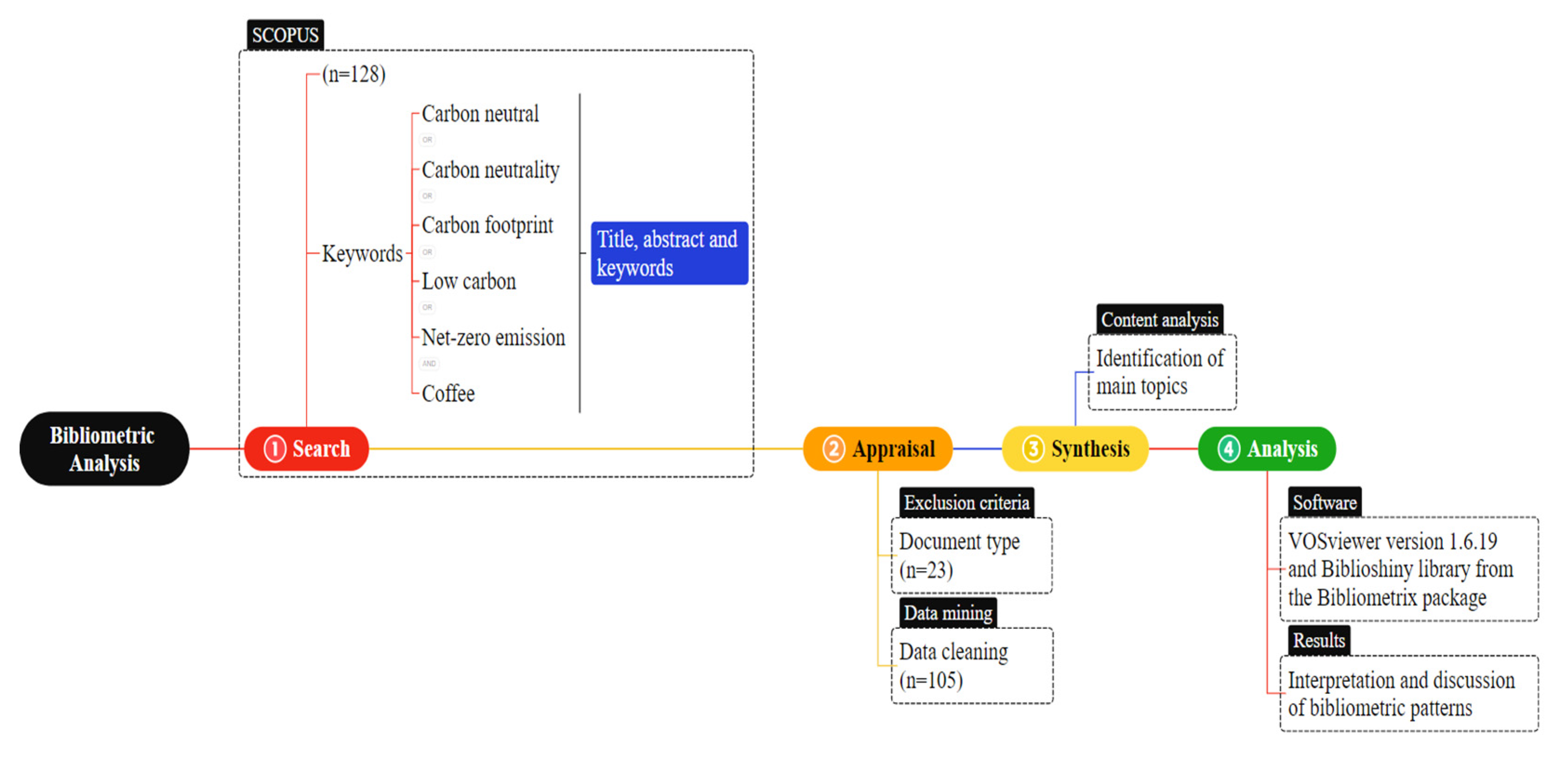

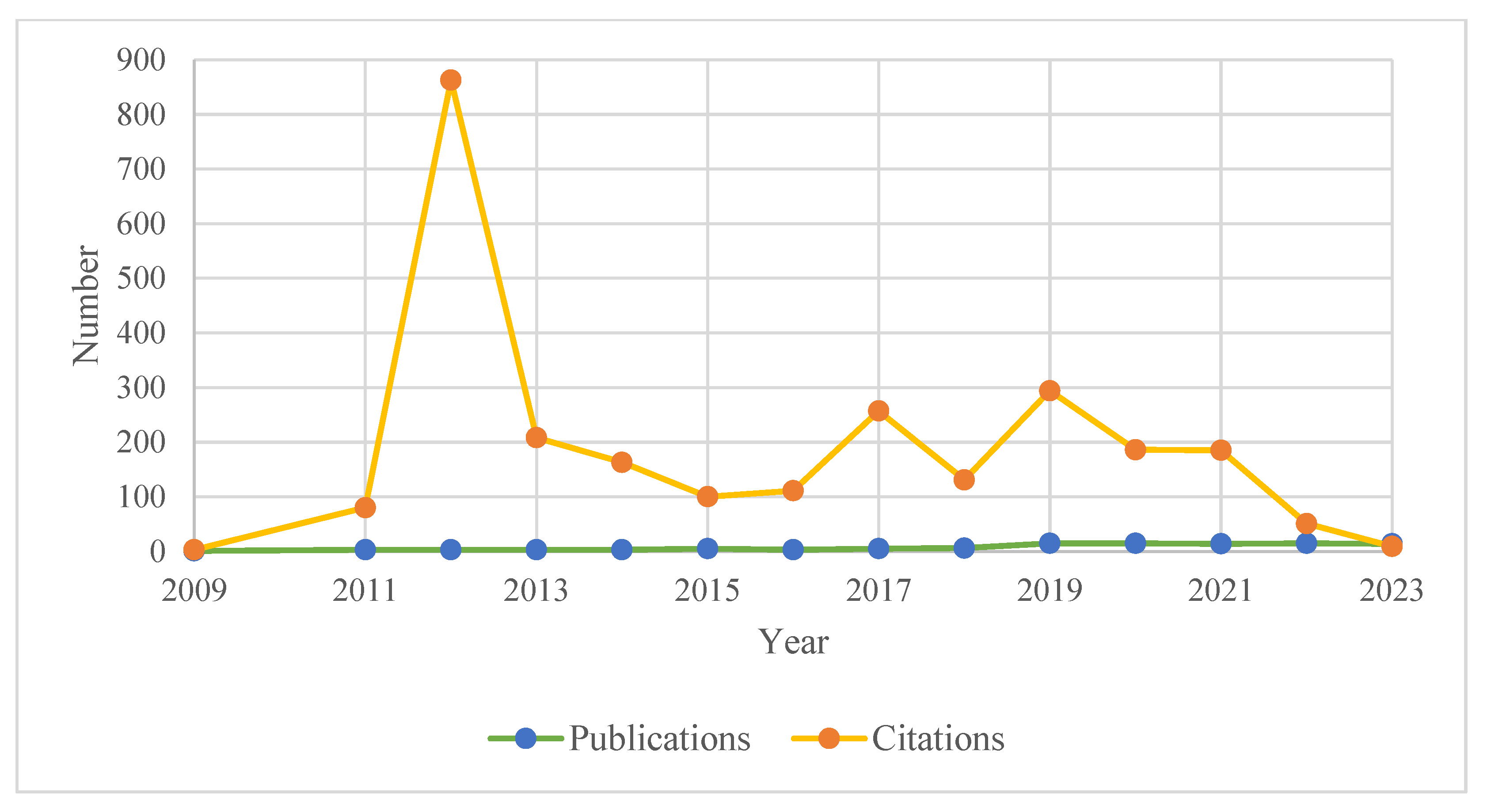
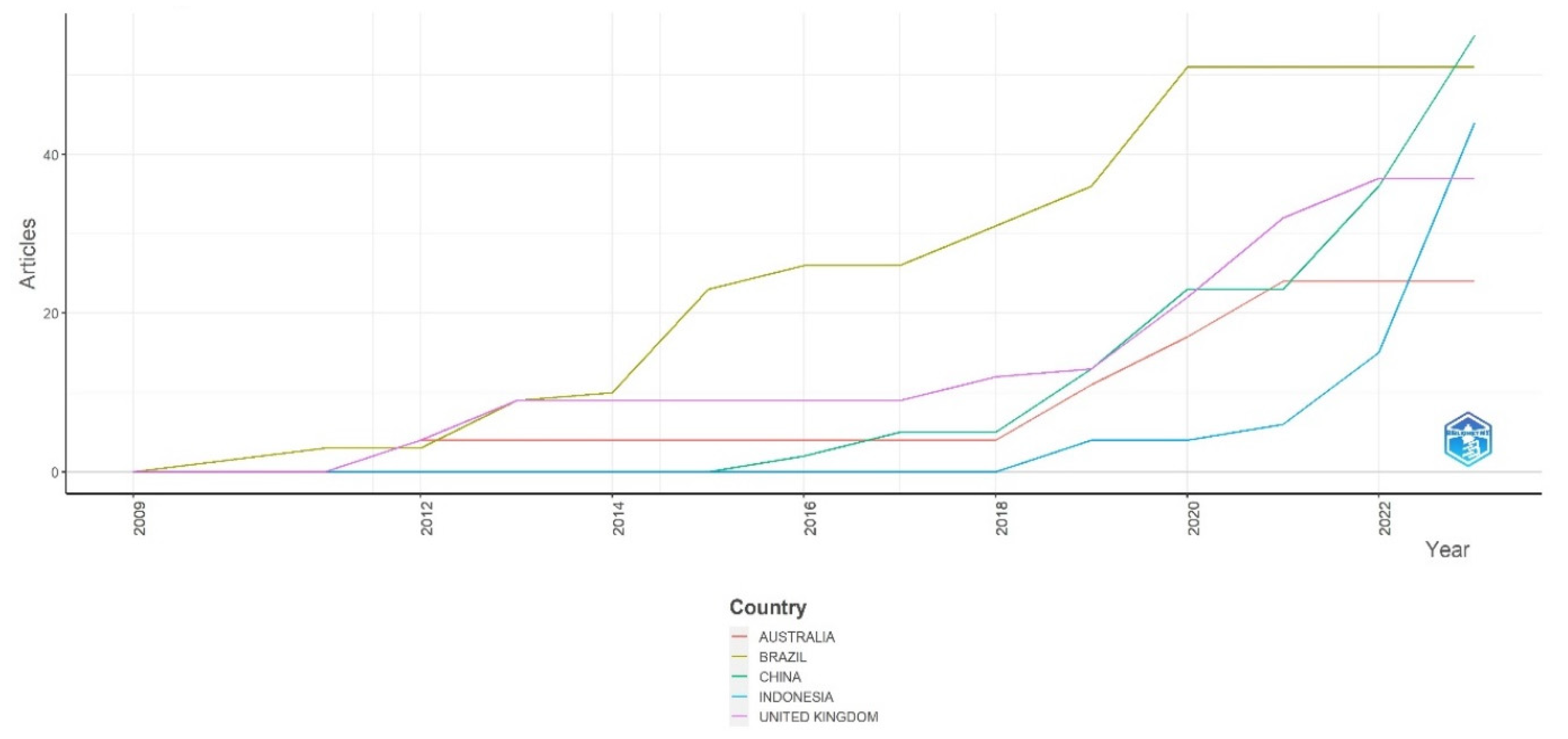
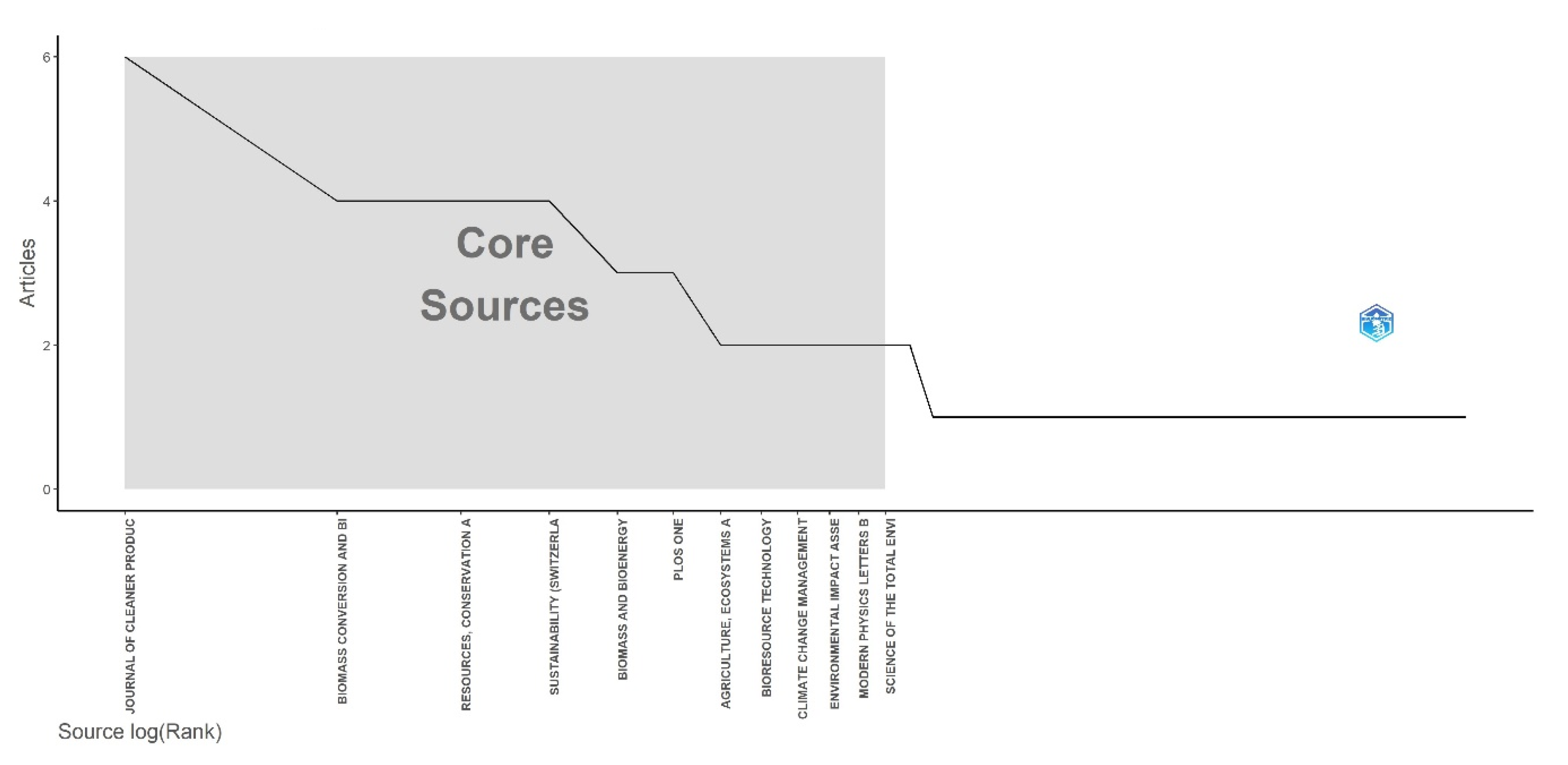



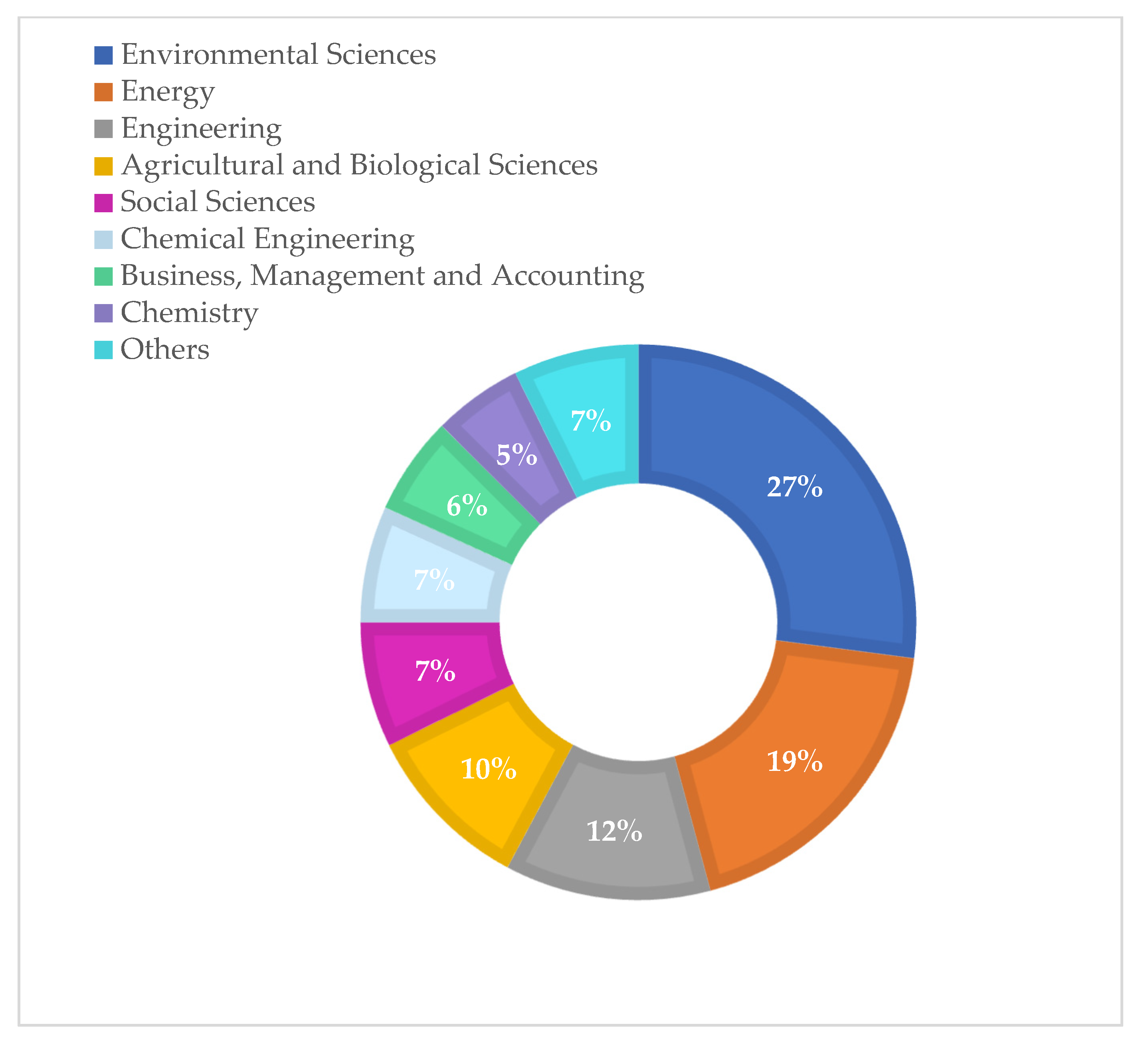

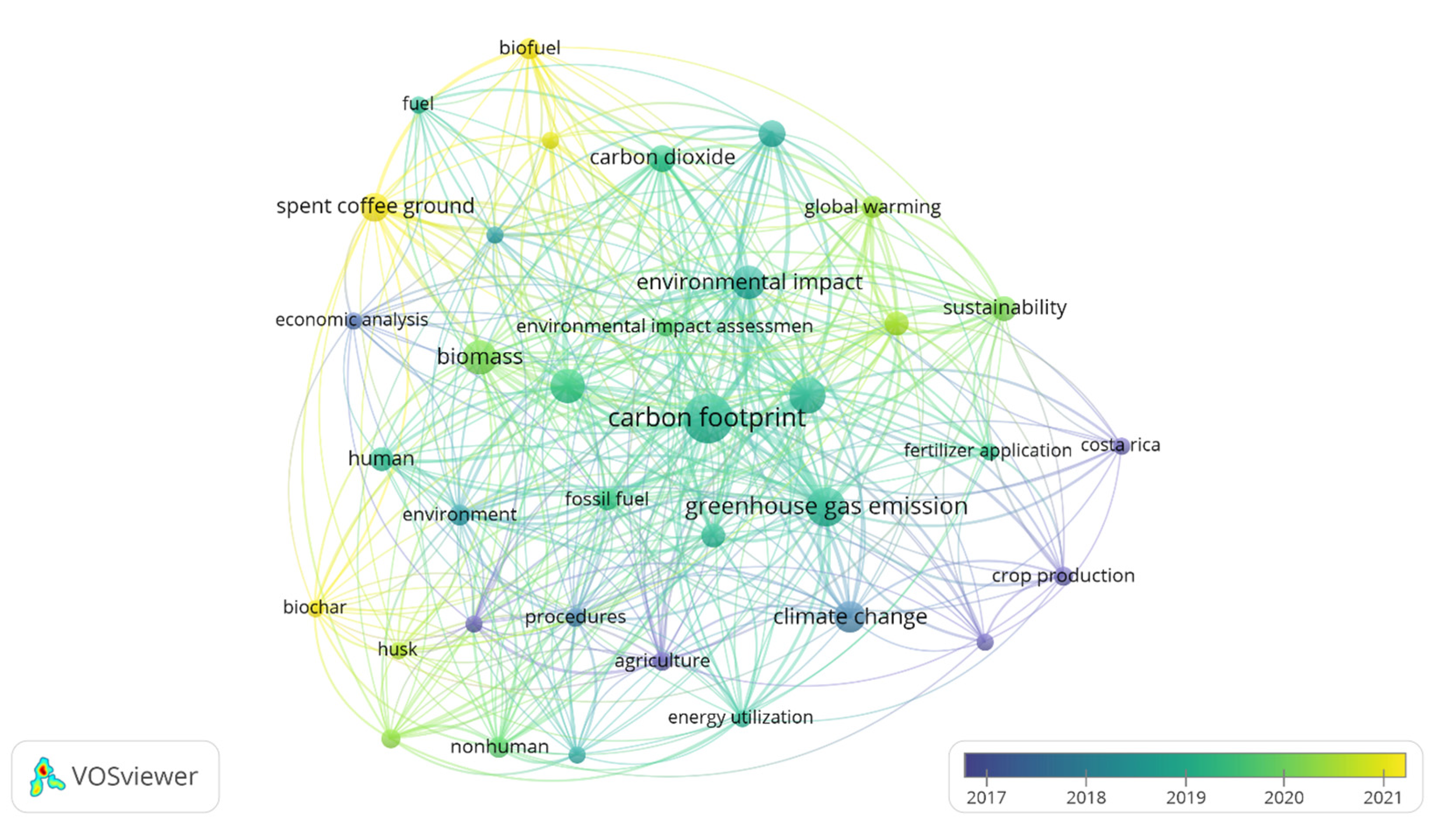


| Title | Author | Journal | Global Impact Factor | Impact Factor Per Year | Normalized Impact Factor |
|---|---|---|---|---|---|
| International trade drives biodiversity threats in developing nations | [36] | Nature | 777 | 64.75 | 2.70 |
| Addressing uncertainty in adaptation planning for agriculture | [50] | Proceedings of the National Academy of Sciences of the United States of America | 197 | 17.91 | 2.84 |
| Energy potential from rice husk through direct combustion and fast pyrolysis: A review | [66] | Waste Management | 158 | 22.57 | 3.07 |
| A better carbon footprint label | [67] | Journal of Cleaner Production | 83 | 10.38 | 2.24 |
| Organic solvents in sustainable synthesis and engineering | [68] | Green Chemistry: An Inclusive Approach | 74 | 12.33 | 3.39 |
| Climate change adaptation, mitigation and livelihood benefits in coffee production: where are the synergies? | [69] | Mitigation and Adaptation Strategies for Global Change | 70 | 7.00 | 1.29 |
| Health and sustainability outcomes of vegetarian dietary patterns: a revisit of the EPIC-Oxford and the Adventist Health Study-2 cohorts | [70] | European Journal of Clinical Nutrition | 65 | 13.00 | 3.32 |
| Greenhouse gas emissions in coffee grown with differing input levels under conventional and organic management | [71] | Agriculture, Ecosystems and Environment | 56 | 4.67 | 0.19 |
| Delayed addition of nitrogen-rich substrates during composting of municipal waste: Effects on nitrogen loss, greenhouse gas emissions and compost stability | [72] | Chemosphere | 54 | 7.71 | 1.05 |
| Characterization of residual biomasses from the coffee production chain and assessment of the potential for energy purposes | [73] | Biomass and Bioenergy | 53 | 10.60 | 2.70 |
Disclaimer/Publisher’s Note: The statements, opinions and data contained in all publications are solely those of the individual author(s) and contributor(s) and not of MDPI and/or the editor(s). MDPI and/or the editor(s) disclaim responsibility for any injury to people or property resulting from any ideas, methods, instructions or products referred to in the content. |
© 2025 by the authors. Licensee MDPI, Basel, Switzerland. This article is an open access article distributed under the terms and conditions of the Creative Commons Attribution (CC BY) license (https://creativecommons.org/licenses/by/4.0/).
Share and Cite
Córdoba-Mora, Y.R.; Lima-Solano, M.; Gómez-Merino, F.C.; Díaz-Porras, R.A.; Contreras-Oliva, A.; Morales-Ramos, V. Key Concepts Used in Climate Change Mitigation Strategies in the Coffee Sector. Sustainability 2025, 17, 7848. https://doi.org/10.3390/su17177848
Córdoba-Mora YR, Lima-Solano M, Gómez-Merino FC, Díaz-Porras RA, Contreras-Oliva A, Morales-Ramos V. Key Concepts Used in Climate Change Mitigation Strategies in the Coffee Sector. Sustainability. 2025; 17(17):7848. https://doi.org/10.3390/su17177848
Chicago/Turabian StyleCórdoba-Mora, Yazmín Rubí, Marisol Lima-Solano, Fernando Carlos Gómez-Merino, Rafael Antonio Díaz-Porras, Adriana Contreras-Oliva, and Victorino Morales-Ramos. 2025. "Key Concepts Used in Climate Change Mitigation Strategies in the Coffee Sector" Sustainability 17, no. 17: 7848. https://doi.org/10.3390/su17177848
APA StyleCórdoba-Mora, Y. R., Lima-Solano, M., Gómez-Merino, F. C., Díaz-Porras, R. A., Contreras-Oliva, A., & Morales-Ramos, V. (2025). Key Concepts Used in Climate Change Mitigation Strategies in the Coffee Sector. Sustainability, 17(17), 7848. https://doi.org/10.3390/su17177848











